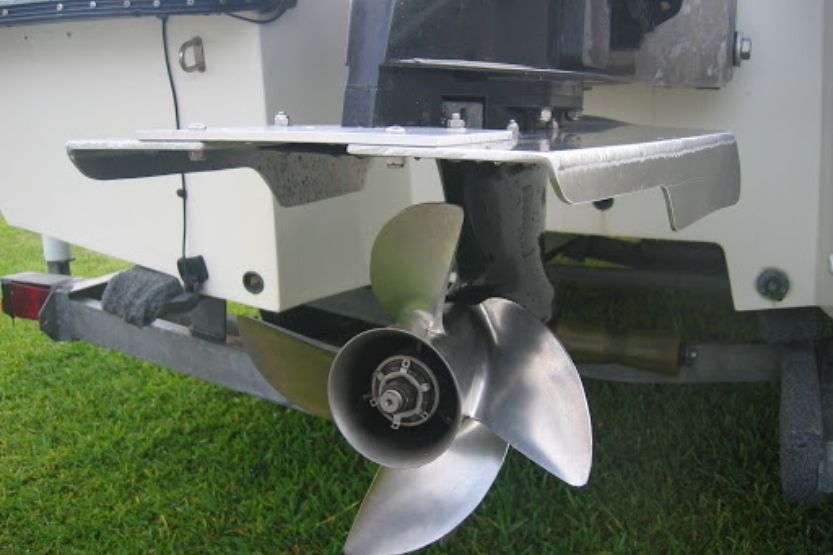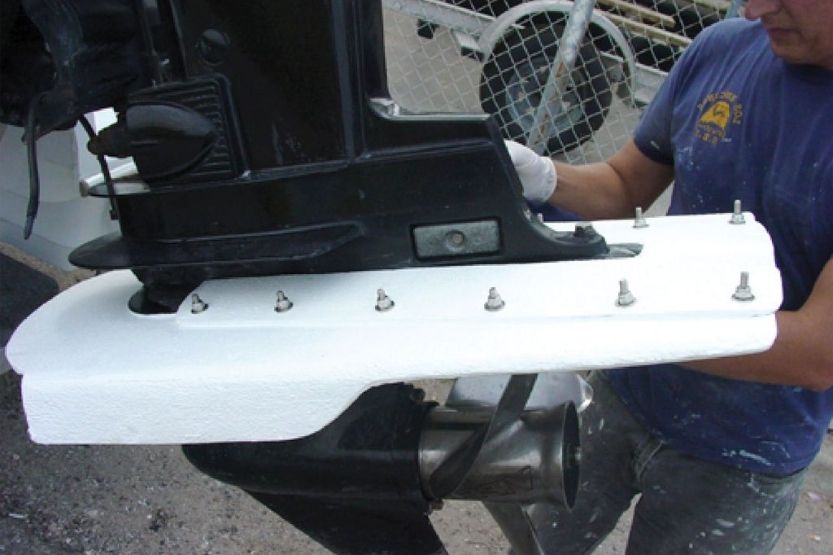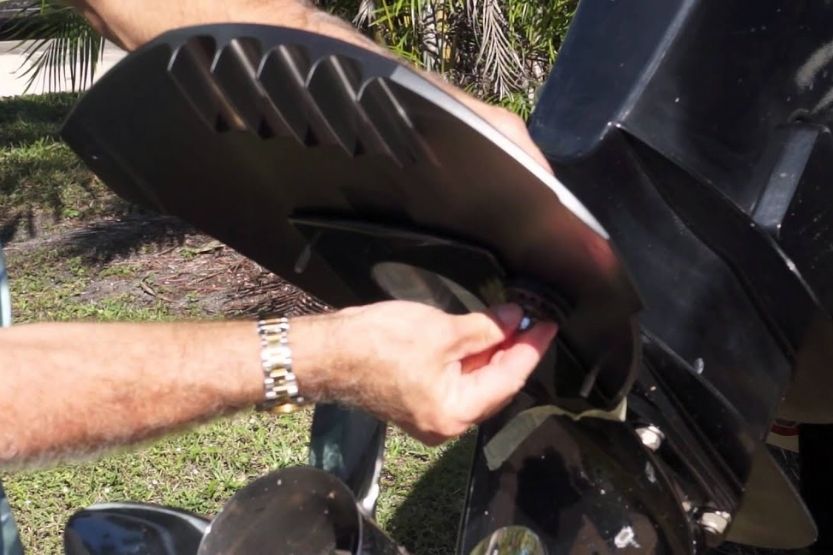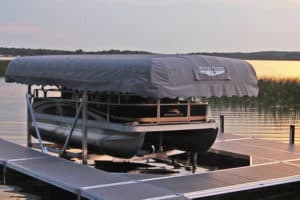Do you feel that your boat seems to be sluggish on the water? There must be something that holds back the power from being delivered to the propeller. A cavitation plate could help speed up your underperforming boat.
A cavitation plate acts as a planing surface so that a boat can move faster on the water. To improve performance, you need to mount this plate on the lower unit of your boat. When you use this plate, you will get a better bow response when trimming the motor. This plate keeps the water down at your prop and intake, which improves water pressure.
You should mount the cavitation plate right at the water level. If the cavitation plate is underwater, you have to raise the motor to get better performance. If you have a bracket, or a Euro transom, the rule of thumb is that the plate should be 1 inch above the hull for every 12 inches back.
Read on to learn more about cavitation plates, what they are, their purpose, and the different types of cavitation plates.
What Is a Cavitation Plate?

If your boat is sluggish on the water, installing a cavitation plate may improve its performance. When mounted on your boat, the cavitation plate will act as a planing surface, and your boat will get on top faster.
Cavitation plates give boats a better bow response when trimming the motor. They are good at keeping the water down at the prop and intake, thereby improving water pressure. To have this effect, the plate must be situated near the water level.
But if the boat has the plate underwater, you can still get better performance by raising the motor. The general rule of thumb is: the plate must be 1 inch above the boat’s hull for every 12 inches back.
The recommended mounting of a cavitation plate is on the lower units of boats because it will help increase performance. It should be almost even or just slightly below the bottom of the boat. If the boat’s motor has a short shaft, the vertical dimension of the transom should be around 15 inches.
More accurately, you can call this plate an anti-cavitation plate because it helps to reduce the sucking down of air from above the boat’s propeller. It cannot stop cavitation but only helps to reduce it.
Cavitation, as well as ventilation, causes air gaps which in turn cause boat propellers to jitter or jump. The vibration that results in causes loss of power, and too much vibration may result in a ‘prop blow out,’ which causes the propeller to spin freely.
The best defense or remedy against cavitation is to trim down the motor, where you control the top rpm or speed of the motor. This will also reduce the erosive damage to the propeller.
This anti-cavitation plate or popular as a cavitation plate, is a full-wrap device that you can mount entirely around the fin’s anti-ventilation fin. It extends forward and trails behind the midsection of the outboard motor.
Why Use a Cavitation Plate on a Boat?
Meaning of Cavitation
To understand the function of the cavitation or anti-cavitation plate, you need to understand the meaning of cavitation. It is the process that occurs when water temperature and pressure decrease around the propeller. This condition causes water to boil.
Bubbles form as the water boils. When these bubbles burst, they cause pitting on the propeller. Pitting is the development of tiny pinholes on metal surfaces. These pinholes compromise the integrity of metals. When pinholes are present on the propeller, it will weaken its structure, affecting the boat’s performance.
Purpose of a Cavitation Plate
This is where the cavitation plate or anti-cavitation plate comes in. The fundamental function of a cavitation plate is to trap water that is exiting or going out from the boat’s tunnel. It prevents the sucking of air into the forward face or part of the propeller.
Water exits the stern clearly when the boat’s hull is planing. In other words, water does not wrap around the transom. And mounting the cavitation plate at the same level as the waterline creates the least amount of drag.
But if this plate is submerged in the water, it will create a considerable amount of resistance. When the boat runs at low speeds, especially if it is long and narrow, the propeller tends to come out of the water as the boat pitches.
How Does a Cavitation Plate Help?
A cavitation plate reduces cavitation by helping to direct and hold water around the propeller blades. It acts similarly to ski by helping to raise the boat’s stern faster. This enables the boat to make quicker holeshots, particularly in shallow waters.
There are cavitation plates that have wings. These types of plates can increase a boat’s tracking performance. There will be varying degrees of improvement when cavitation plates are installed in different kinds of boats. But the most dramatic improvements are seen in tunnel hull boats when cavitation plates are used.
A cavitation plate pushes down the boat’s front or bow to help it get on the plane quicker and remain on the plane when running at low speeds. That is why you have to mount it at a certain height. If it is in the correct position, it will barely skid on the water surface. It will cause a steady flow of water to the propeller while preventing outside air from coming in.
Types of Cavitation Plates

Since there are different kinds of boats, there should be an ideal cavitation plate for your boat. That is why there are also different types of cavitation plates. The cavitation plates that you will find in the market could be one of the following:
- One size fits all – makers of these cavitation plates claim that they are universal so that you can use them in most types and sizes of boats.
- Plates that require holes for mounting
- Stainless steel plates – when these plates are mounted on aluminum hulls, electrolysis sets in, which increases the chances of corrosion of the metal.
- Aluminum plates – has the same corrosion risks as stainless steel plates
- Plates with narrow edges above the lower unit plate – the plates groove the cast aluminum of the lower unit of the boat, eventually saw off its edges.
- Plates that are ‘finished’ on the top side but the rough glass on the underside – not the best because the underside should also be smooth since water travel on the underside of the plate.
How to Install a Cavitation Plate
Basically, the cavitation plate must always be in the water when the boat is running. It should be located right at that water level. The rule of thumb should be one inch above the boat’s hull for every 12 inches back. There are boat dealers who set it at 1/2 inch above the hull’s bottom when the motor is sitting straight up and down or at sitting level.
If you raise the motor and the cavitation plate is under the water, you will likely improve the performance of your boat. Setting the height of the engine correctly makes a lot of difference. So, the cavitation plate should be even or slightly below the bottom. If your boat motor has a short shaft, the vertical dimension of the transom should be around 15 inches.
There will be differences in the running measurements against vertical measurements due to the different angles of transoms. You have to check the measurements from the cavitation plate to the inside of the engine’s bracket for mounting.
To mount the plate correctly, raise the motor until the plate is equal in height or just below the running plane of the keel by about 3/4 inches. It is typical for engines with short shafts to require a vertical measurement of 17 1/2 inches.
The Best Use of Cavitation Plates
Cavitation plates are ideal for boats with tunnel hull designs, especially those that have full tunnels. There are three kinds of tunnel hull boats:
- Full tunnel – this boat has a tunnel that starts under the center console of the boat and the center of the keel that is integrated into the hull going backward to the transom. Water is fed to the propeller through this area while the boat is on the plane. This also gives the boat its shallow water ability with the help of a jack plate.
- Half tunnel – the tunnel on this boat starts farther astern and between the center console and transom about midway. Its function is similar but not as forceful as the full tunnel.
- Pocket or no tunnel – the tunnel on this boat can be more correctly described as an indentation. The depressed part is shaped like a pan at the keel, going to the bow about 8 to 15 inches. It is designed to give greater stability to the hull while improving the boat’s shallow planing capabilities.
Cavitation plates are most useful to boats with full tunnel hulls because they will improve the shallow water performance of these boats. The cavitation plate will force the bow down and create lift on the point farthest on the rear.
There will be less cavitation while the boat is turning. It will improve the propeller’s ability to sustain a solid bite. This will minimize slippage because it introduces air into the stream of water feeding the propeller while running.
How to Choose the Best Cavitation Plates
To help give your boat the best performance, you should use the right kind of cavitation plate. Here are some tips on how you can choose the right cavitation plate for your boat:
1. Choose the Correct Size
Cavitation plates are available in four different sizes, namely large, medium, small plus, and small. There are several factors that you should consider in determining the plate size. Here are some suggestions:
- Large cavitation plates – these plates are designed for boats that are powered by at least 115 horsepower motors. They have the biggest planing surface among the cavitation plates available. These plates are also commonly used on boats with flat transoms. They can be notched if the boat owner wants them that way.
- Medium plates – these plates are normally mounted on boats powered by at least 90 hp motors. They are best for boats with ‘key slot’ or inset transoms. This will keep the plate from contacting sponsons or extensions on the boat’s body while the boat is turning.
- Small Plus plates – these plates can work for some boats that are powered by 90 hp motors. They are a bit longer than the small cavitation plates.
- Small plates – these plates are ideal for boats that have motors ranging from 25 to 70 hp.
2. Choose a Plate Made of Strong Materials
Go for cavitation plates that are made of strong and durable materials. Moreover, some of the stronger plates available in the market are made of stainless steel with laminates, while some plates are made of biaxial glass with additional laminates on their front. Choose a plate with a high strength to weight ratio instead of a simple plate made of mat fiberglass.
3. Choose a Plate That Can Be Mounted Easily
Some plates need holes for mounting. That means extra time and effort in drilling holes on your boat. Choose a cavitation plate that can be mounted without drilling holes. These plates are the ones you can install yourself.
4. Choose a Plate with the Best Design
Select a cavitation plate the can improve the turning capacity of your boat. The plate should also be able to withstand the vibration it will experience while the boat is running.
Add a Hydrofoil for Even Greater Speed and Stabilization

You can attach a hydrofoil (performance stabilizer) to the cavitation plate for even greater speed and stabilization. The below hydrofoils are easy to install, improves the top speed of your boat, and helps save on fuel costs:
Hydrofoil SE 400 Sport in Dark Grey
Click here to see it on Amazon.
The narrow streamline shape of the SE 400 Sport Hydrofoil provides quick, precise control. The unique design eliminates the cupped underside and downturned trailing edge, so there’s no drag.
Sting Ray XRIII Senior Hydrofoil Stabilizer Gray
Click here to see it on Amazon.
The Sting Ray XRIII Hydrofoil has a sleek, hydrodynamic profile that provides better performance for engines up to 300 HP. By capturing the prop wash, and the XRIII Hydrofoil harnesses power for added thrust.
Conclusion: Cavitation Plate
If you want to get your boat on top faster, you need to use a cavitation plate because it will act as a planing surface. You can improve the performance of your boat if you will mount this plate on the lower unit of your boat.
If this plate is installed on your boat, you will get a better bow response when trimming the motor. It will keep the water down at your prop and intake, which will then improve water pressure.





![Read more about the article How to Drive a Boat? [10 Fundamentals]](https://boatinggeeks.com/wp-content/uploads/2020/10/how-to-drive-a-boat-300x200.jpg)
![Read more about the article How Much Is Boat Insurance? [10 Cost Factors]](https://boatinggeeks.com/wp-content/uploads/2020/10/how-much-is-boat-insurance-300x200.png)